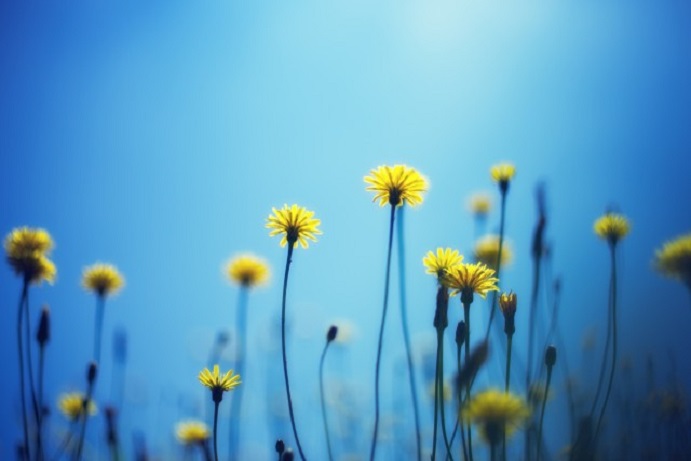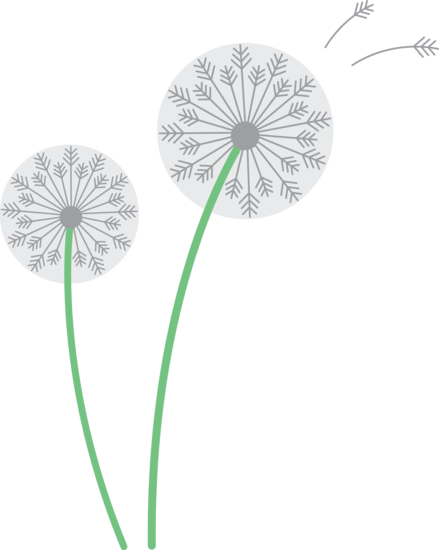Dandelion Folklore
Historical and Cultural Legends & Mythology of the Dandelion -- Urban Lore, Superstitions and Unique Dandelion Factoids.
 [View As Slideshow]
[View As Slideshow]
Aside from being nice to look at, dandelions can be a lot of fun and joy for children and adults alike. The well-known dandelion related tradition is to pick a dandelion that has the full white seed "the puff ball" intact, and to 'make a wish' and then blow the seeds away. It's fun to watch the seeds scatter in away in the breeze. Wherever each one of the seeds lands there will be another dandelion! Also, If you are able to catch a flying dandelion seed, it's also a tradition to make a wish.
Nowadays, a lot of people dislike dandelions taking over their backyards and will do whatever they can to rid the grass of them. But up until about the 1800's, people would pull the grass out of their lawns to actually make more room for dandelions and other useful weeds, like chickweed, chamomile and mulva. This is because the dandelion has many medicinal and nutritional benefits. These days, the dandelion is still prized for its use in a variety of homemade recipes, as well as the many ways it can be used for good health and healing.
Dandelion is said to enhance psychic abilities when brewed in a tea. Dandelion roots in a tea is said to also aid divination and prophetic dreaming. A tea made from the roots, and then left steaming and placed beside the bed will call or attract spirits. Also, burying a dandelion in the northwest corner outside of the house, is said to bring favourable winds.
One traditonal legend about the dandelion states that if a child goes outside and looks for the tallest dandelion stalk that they can find in the early spring, then the length of the stem will be about equal in eaches to how much taller the child will grow in the coming year.
An interesting metaphysical association states that the dandelion is the only flower that represents the 3 celestial bodies of the sun, moon and stars. The yellow flower resembles the sun, the puff ball resembles the moon and the dispersing seeds resemble the stars.
In some cultures, dandelions were considered symbols of sorrow and grief. The dandelion was well known since the time of Moses, and it represents the bitter herbs found in the last supper. Dandelions are sometimes used to represent the Passion of Christ in theological symbolism, as well as being one of the bitter herbs of the Passover. In Israel, dandelions grow from the extreme north at Mount Hermon south to the Negev Dessert.
Yellow dandelions petals are often used as a variation on the daisy-petal-plucking childhood past time of “he loves me, he loves me not”. Another romantic dandelion oracle legend says that if you blow on a white dandelion head and all of the seeds scatter away, then you are well loved by your romantic interest. If some of the seeds still cling to the stalk, then your love interest has reservations about the relationship.
In some magical traditions, dandelions are associated with the goddess Aphrodite because of her connection to bees. In others, this plant is connected to the underworld, by way of its association to the goddess Hecate.
The dandelion is an excellent barometer. It's actually a common and most reliable way to predict the weather. When the blooms have seeded and are in the fluffy, feathery condition that its weather prophet facilities come to the fore. The ball fully extends if the weather will be fair, but it shuts like an umbrella if rain is approaching. If rain showers will be continuous then it keeps shut all the time, only opening when the rain has ceased.
In an ancient medieval ritual states that if a child holds a yellow dandelion flower beneath their chin, and if a golden glow appears, it would indicate that the child would be rich one day. In 18th century England children held the dandelion under their chin and the more golden the glow the sweeter and kinder they were said to be.
In astrology, each herb falls under the dominion of a particular planet. Dandelion is ruled by the planet Jupiter. Jupiter frequently rules plants that grow abundantly and dandelion is a particularly good example. Such is its power to multiply that a single dandelion root flowering in the spring is capable of propagating five new generations.
The dandelion is often referred to as the rustic oracle; its flowers always open around sunrise at about 5 A.M. in the morning, and shut at dusk around 8 P.M. in the evening. Because of this it has been called the "Shephard's Clock".
Making a wish immediately before blowing on a dandelion states that your wish just might come true. Another traditional belief was the that the number of seeds left on the stalk after blowing the seed head indicated the number of children that a girl would have in later life. Another legend claims that the number of seeds remaining after blowing the seed head are how many years one has left to live.
Dandelions represent and have been associated with the qualities of warmth, healing, radiance, illumination, growth and transformation. Dandelions also represent clarity, strength and the ability to overcome adversity.
Making a wish immediately before blowing on a dandelion states that your wish just might come true. Another traditional belief was the that the number of seeds left on the stalk after blowing the seed head indicated the number of children that a girl would have in later life. Another legend claims that the number of seeds remaining after blowing the seed head are how many years one has left to live.
Dandelions represent and have been associated with the qualities of warmth, healing, radiance, illumination, growth and transformation. Dandelions also represent clarity, strength and the ability to overcome adversity.
Making a wish immediately before blowing on a dandelion states that your wish just might come true. Another traditional belief was the that the number of seeds left on the stalk after blowing the seed head indicated the number of children that a girl would have in later life. Another legend claims that the number of seeds remaining after blowing the seed head are how many years one has left to live.
Dandelions represent and have been associated with the qualities of warmth, healing, radiance, illumination, growth and transformation. Dandelions also represent clarity, strength and the ability to overcome adversity.
Making a wish immediately before blowing on a dandelion states that your wish just might come true. Another traditional belief was the that the number of seeds left on the stalk after blowing the seed head indicated the number of children that a girl would have in later life. Another legend claims that the number of seeds remaining after blowing the seed head are how many years one has left to live.
Many beliefs centre on dandelions answering questions or bringing good luck. When the seeds are blown of a dandelion it was said to carry thoughts and affections to a loved one.
When dandelions appear in dreams, they are thought to represent happy unions. They are also considered to be symbols of hope, summer and childhood.
It is said that if dandelion is woven into a wedding bouquet by the bride, then it will bring good luck for a newly married couple.
Another common belief is that the number of seeds left on the stalk after blowing away at the top will predict the current hour of the time of day.
A silly legend states that if you take a dandelion and tickle a person's chin with it, and they laugh, then the person likes butter; but if the person does not laugh, then they have no taste for butter.

